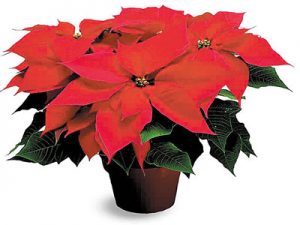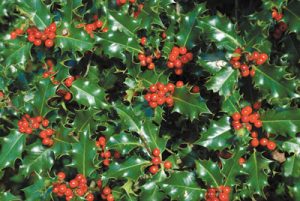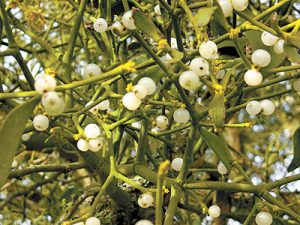November 28, 2016
Poinsettia, Holly and Mistletoe
 By Eloise Graham
By Eloise Graham
These three plants make us think of winter decorating and holiday celebrations. But why and what is their story? Do we think Christmas when we see the poinsettia with its green leaves that turn to a flaming red? Do we think festivities when we see the bright, shiny, curly dark green leaves and the accentuating red berries of the holly plant? Do we feel whimsical when we see the curvy, intertwining branches and white pearl-like berries of the mistletoe
 Poinsettia: This flowering plant is indigenous to Mexico and the warmer climates. In its natural habitat, it grows wild and is actually a shrub. The name is derived from English. In 1825, Joel Roberts Poinsett, the first United States Minister to Mexico, introduced the plant to the US. The red “flower petals” are actually the leaves that change colors from the green hues to other colors due to a process called photoperiodism: a process of needing 12 hours of darkness per day for at least 5 days. This plant has become commercially important with over 100 varieties of hybrids producing a full color spectrum. The actual flower is only the little yellow center. Once it has lost its pollen, the outer leaves will drop.
Poinsettia: This flowering plant is indigenous to Mexico and the warmer climates. In its natural habitat, it grows wild and is actually a shrub. The name is derived from English. In 1825, Joel Roberts Poinsett, the first United States Minister to Mexico, introduced the plant to the US. The red “flower petals” are actually the leaves that change colors from the green hues to other colors due to a process called photoperiodism: a process of needing 12 hours of darkness per day for at least 5 days. This plant has become commercially important with over 100 varieties of hybrids producing a full color spectrum. The actual flower is only the little yellow center. Once it has lost its pollen, the outer leaves will drop.
Holly: Holly is a flowering plant, a genus of 400 to 600  species in the plant family of Aquifoliaceae.It grows widespread throughout the temperate and subtropical zones of the world. A very versatile plant in that is can be either evergreen or deciduous. It can be a tree, shrub or a climber. The small fruits, although often referred to as berries, are technically drupes. Drupes are a fleshy fruit with a thin skin and a central stone containing the seed i.e; the plum, cherry or olive. In the case of holly, the stone of this drupe contains ten seeds.
species in the plant family of Aquifoliaceae.It grows widespread throughout the temperate and subtropical zones of the world. A very versatile plant in that is can be either evergreen or deciduous. It can be a tree, shrub or a climber. The small fruits, although often referred to as berries, are technically drupes. Drupes are a fleshy fruit with a thin skin and a central stone containing the seed i.e; the plum, cherry or olive. In the case of holly, the stone of this drupe contains ten seeds.
 Mistletoe: Mistletoe is the common name for “most obligate hemiparasitic plants.” That actually
Mistletoe: Mistletoe is the common name for “most obligate hemiparasitic plants.” That actually
means that mistletoe is a parasite. The plant attaches to and penetrates branches of a tree or shrub. It is native to England and parts of Europe. It is not native to, but has been cultivated and is grown, in California. The leaves are oval, smooth-edged and it has waxy, white berries that grow in clusters from two to six berries per cluster.
Filed Under: History
Trackback URL: https://www.50pluslife.com/2016/11/28/poinsettia-holly-and-mistletoe/trackback/


